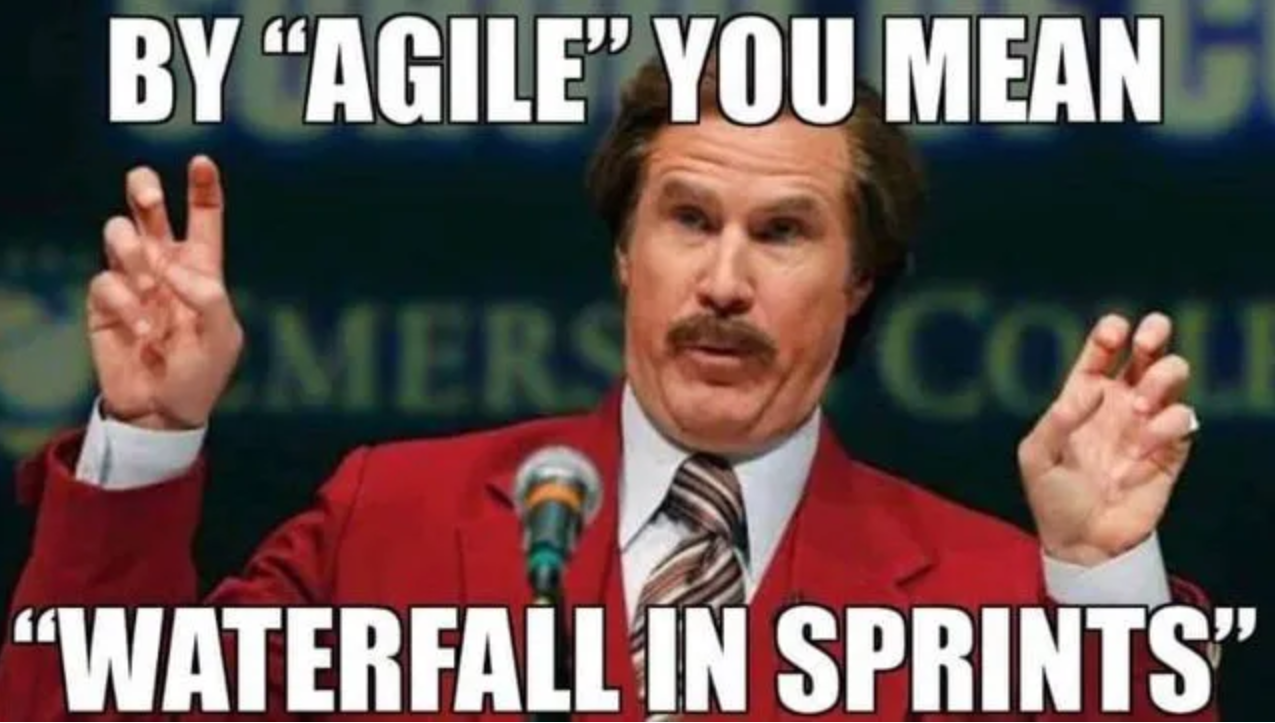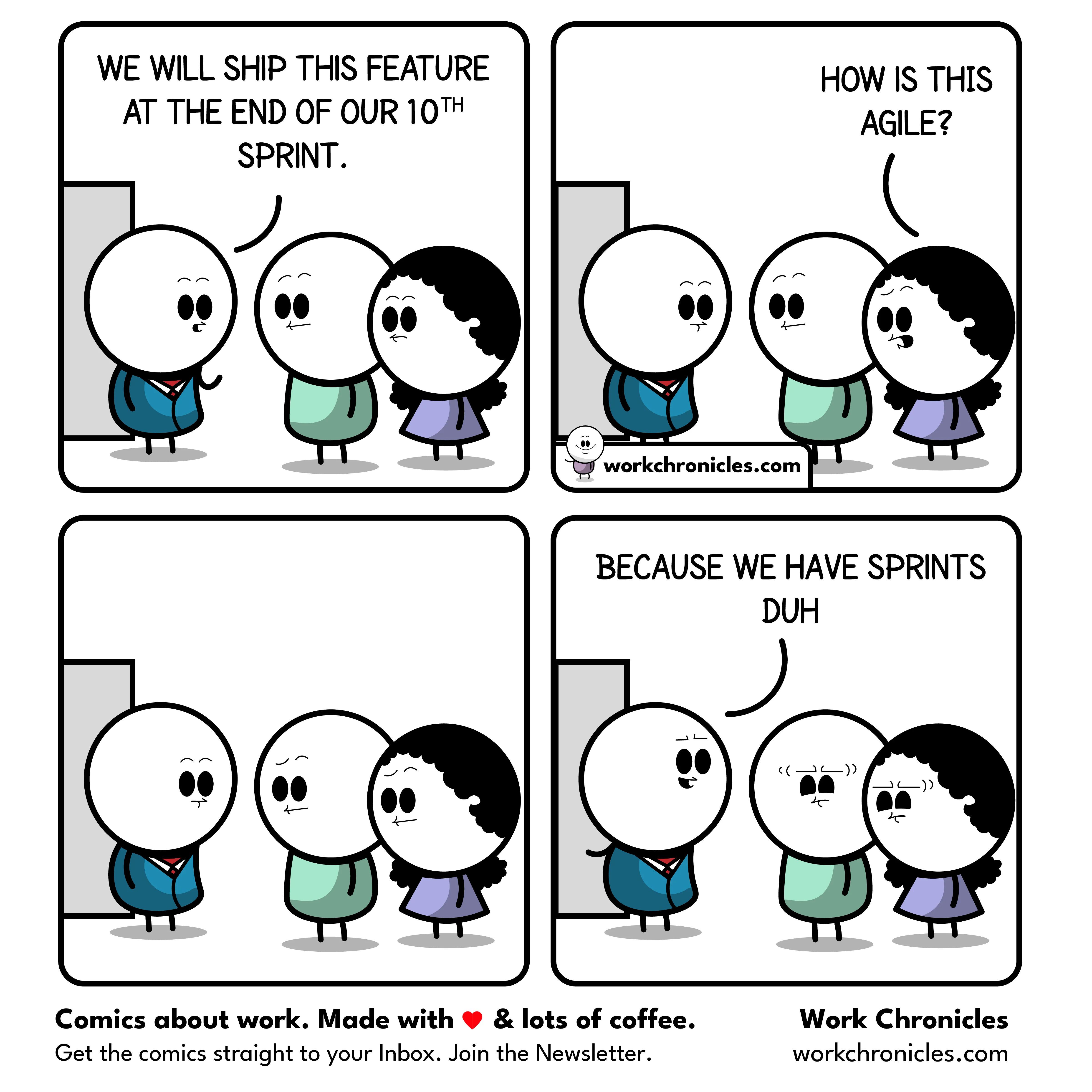Unmeasured: Part 3 – The agility illusion
Agile is everywhere.
Every team is agile. Every board is a Kanban. Every meeting is a stand-up. Every backlog is groomed. Every two weeks is a sprint.
It looks good. It sounds good.
But let’s be honest—most of the time, it’s complete theater.
We don’t have an agility problem.
We have a pretending-to-be-agile problem.
How delulu are you?
Rituals without responsiveness
You can follow every step in the agile playbook and still be stuck in old behaviors:
- Stand-ups that are just status updates
- Sprints that are really just mini-waterfalls with fixed scopes
- “Product owners” who just translate stakeholder requests
- “Retrospectives” that produce action items nobody follows up on
- “Velocity” charts used to pressure teams into overcommitting

These are rituals. And they often exist without the mindset that makes agility work: trust, adaptability, continuous improvement.
Teams burn through tasks at speed, but they’re not solving the right problems. They’re just sprinting in place.
If you ship fast but never stop to ask, “Should we be building this at all?”
You’re not agile. You’re just efficient at being wrong.
Weaponizing the Agile Manifesto
The Agile Manifesto wasn’t supposed to be a loophole.
It was written as a rebellion against heavy processes and rigid hierarchies: a call for teams to focus on people, collaboration, and real outcomes. But today? It’s often misquoted, misused, and turned into a shield for bad behavior.
Let’s talk examples:
“Working software over comprehensive documentation” becomes
“We don’t write documentation at all.”“Customer collaboration over contract negotiation” becomes
“We’re building cool stuff… we throw it over the fence and keep fingers cross in hope for the customer likes it.”
Agility gets turned into an excuse not to plan, not to reflect, not to write things down. That’s not adaptive. That’s lazy.
Agile in form, waterfall in spirit
Many organizations claim to be agile but still operate with a waterfall mindset:
- Quarterly “agile” planning cycles that lock in work for 3 months
- Story point estimates (the bane of my existence) treated as fixed commitments
- Teams with no autonomy, just assigned work from the top
- Managers using Jira like it’s a performance tracker
You get speed, but not flexibility. Delivery, but no discovery. A product roadmap that’s full, but nobody’s sure why those things are on it.
It’s agile in form, but waterfall in spirit. (And a cry for help!)

The control paradox
Agile is supposed to be about trust. But in practice, it’s often wrapped in even tighter control:
- More metrics. More meetings. More layers.
- Teams are “self-organizing” on paper, but still need approval for everything
- Leaders say they want experimentation (but only if it delivers predictable results on a fixed timeline with zero risk 🤡)
That’s not agility. That’s micromanagement in a hoodie and cool sneakers.
The Measurement problem (again)
Agile teams are constantly measured: velocity, burndown, throughput, cycle time. These can be useful. But when they become targets, they backfire:
- Velocity becomes a scoreboard; teams inflate story points or sandbag to hit the number (been there, done that 😇)
- Burndown charts become sources of anxiety instead of insight
- “Team performance” becomes about moving units of work, not solving actual problems
Just like with productivity metrics, these tools stop being helpful when they’re used to judge instead of to learn.
If your metrics create fear instead of curiosity, you’ve lost the point.
So what does real agility look like?
Real agility is not stand-ups, sprints, or post-its on a whiteboard.

It’s a system that:
- Empowers teams to make decisions
- Encourages reflection and iteration
- Prioritizes value over velocity
- Builds space for thinking, not just doing
- Respects quality—including tests, documentation, and design
- Focuses on solving real customer problems, not just shipping features
It’s a system where people are trusted to change course. To challenge the brief. To say, “This isn’t the right thing to build”.
See how this neatly ties into the 2nd part of my unmeasured series (please, do yourself a favor and go read this if you came unprepared to this one, thanks)
Real agility supports “Change the Business” work.
Fake agility just helps you “Run the Business” faster.
Final thoughts
You can’t measure agility by counting how often you stand up. You can’t fake adaptability by sprinting harder. If the rituals are there but the responsiveness isn’t, it’s not agility. It’s performance. And performance is exhausting.
Part 4 will explore the emotional cost of productivity theater, and what it means to measure well-being, not just output.
Until then, maybe skip the retro this week and ask the real question:
Are we actually getting better? Or just faster at doing the wrong things?
More parts of this series
- Unmeasured: Part 0 - More ain’t better
- Unmeasured: Part 1 – We are measuring the wrong things
- Unmeasured: Part 2 – The difference between running and changing your business
- Unmeasured: Part 3 – The agility illusion
- Unmeasured: Part 4 – The emotional cost of the productivity theater
Some resources
You May Also Like
Unmeasured: Part 2 – The difference between running and changing your business
Most organizations track the work they can see. Emails sent, cases closed, dashboards filled. But what about the strategic, invisible work of transformation? In Part 2 of the Unmeasured series, we …
Unmeasured: Part 1 – We are measuring the wrong things
Timesheets don’t measure what matters. They don’t reflect impact, focus, or strategy. Most of the time, they’re fiction—written in a rush, approved without review, and used to justify a broken idea of …
Unmeasured: Part 0 - More ain't better
When overwork is a badge of honor and AI automates output, we’re still measuring productivity like it's the 20th century. This first post in the Unmeasured series confronts the culture of "more" and …





